Whereas spring often feels like a warp speed relay race, the slow motion spring of 2018 gives us a chance to appreciate plants that brighten the days of leaden skies.
This year daffodils – narcissi – have had the opportunity to shine, giving us their own brand of yellow optimism.
I’ve taken the time to appreciate daffodils and I have overcome a 40 year grudge caused by a childhood horticultural flop.
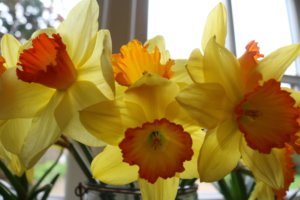
A jolly vase of back-lit daffodils with marmalade centres
A childhood disenchantment with the daffodil
It was meant to be a joyous drift of golden daffodils to celebrate my junior school’s centenary. It turned into a muddy non-event with barely a petal in sight.
In Autumn 1978, each girl at my school had been given a daffodil bulb to plant. The next spring I awaited the yellow drift with excitement but only a handful of flowers came. The following year there were none, and I was bitterly disappointed.
It’s possible my disenchantment was shared in the Staff Room but no mention was ever made of the daffodil debacle. Maybe the collaborative act of planting was deemed more important educationally than the lack of a golden display.
My childhood gardening knowledge was small but I had a hunch that planting those bulbs in the deep shade of large trees, where small girls ran wild every break-time, wasn’t really a good move.
Even so, for years the daffodils themselves were the focus of my grudge.
They’d let me down.
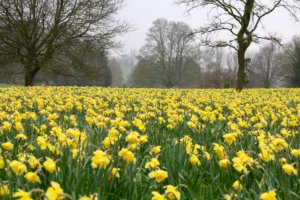
How my school centenary display should have looked if planted in open parkland rather than in a deeply shaded playground – this massed planting is at Hughenden Valley, High Wycombe.
Taking time to study the form
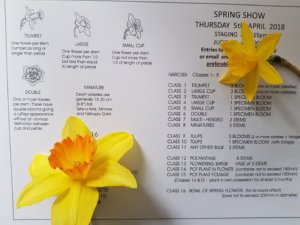
Studying my local horticultural society’s Spring Show classes has given me a better understanding of narcissus varieties
This year is different and I’ve got a renewed attraction to daffodils. I’ve joined a local horticultural society and It’s Spring Show classes caught my attention.
More than half of the competition classes are for narcissi – split into trumpet, large cup, small cup, double, miniature and multiheaded classes.
Interest piqued, I ventured into the garden between rain-showers to see how many of the different types I had. What I saw took me by surprise. Looking from a distance to be a standard pale yellow daff, up close I saw a long trumpet form with delightful twisted petals.
It turned out that I have 12 different varieties growing and I had never really looked that closely at them before. I don’t know the names of all of them but I’ve started staring at them and they truly are varied and so beautiful.
It’s like cupid’s bow has hit me and inflamed my narcissus desire.
Dazzling Daffodil variety
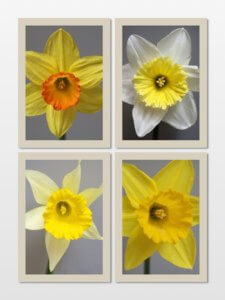
So much daffodil variety
The first amazing thing about daffs is their symmetry. It’s not a perfect symmetry, but certainly a regularised form, where all except the double varieties are concerned.
Six petals, arranged round the central cup, every other one overlapped in front so that when the light shines through, the shadowed pattern is stunning.
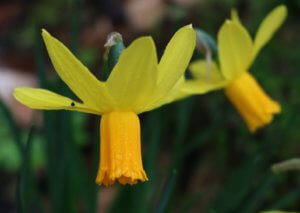
An unnamed variety from my garden with tangerine trumpet and blown back petals
Some of the petals are broad, flat and triangular. Others stretch backwards away from the trumpet as if in a wind tunnel. Some have thin, twisted petals forming a spinning catherine wheel around the trumpet.
They range in colour from ivory to pale cream, through primrose and lemon to proper tinned custard yellow. The cup and trumpet colours also vary tremendously from marmalade orange to pale cream and even rosy pink. Sometimes the trumpets and petals are matching, others offer pleasing contrast.
Then there are the cup shapes. These can be properly long, a brass band trumpet deserving of the name. Others are very short indeed, more of a ruffle, like those of 70s tennis players’ frilly knickers. Some are double and almost mind-blowingly messy.
Some have no scent at all, some a delicate polleny-sweet smell and others a full-on honeyed fragrance that will fill any room.
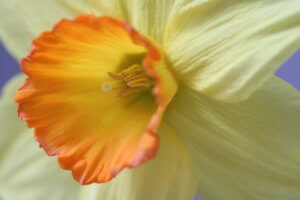
Narcissus ‘Sacajawea’ blooming in time for the Spring Show
My quick garden audit meant that I wasn’t surprised to discover that there are an incredible 13,000 different daffodil hybrids.
Sadly, I only know the names of 3 of the daffodils in my garden, as these are ones I planted rather than inherited.
The names barely matter though and next autumn I shall be studying the mail-order brochures for new varieties to plant and enjoy gazing at next year.
Naturalising daffodils
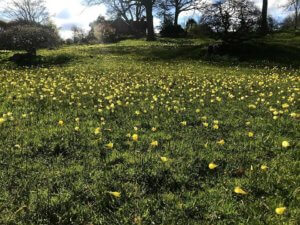
The alpine meadow at RHS Wisley in Surrey – drifts of naturalised Narcissus Bulbocodium. Photo credit – Emma Allen
If you’re looking for a meadow effect in your garden, naturalising daffodils is a lovely idea. Naturalising essentially means that the bulbs remain happily and come back year after year. Most daffodil hybrids will stay put and bulk up, as with snowdrops, and as pictured in the swathes at Hughenden Valley. Some, such as the native Lent Lily Narcissus pseudonarcissus should spread by seed dispersal.
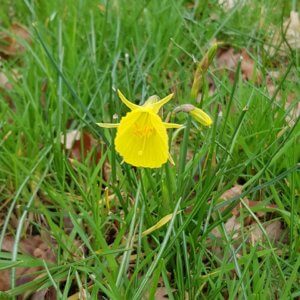
Hoop-petticoat daffodil
The RHS has a useful guide to naturalising narcissus and other bulbs, including a list of varieties to try.
This coming autumn I’m planning on planting some Narcissus bulbocodium into the grass in my small orchard. Native to southern and western France, Portugal, and Spain they will hopefully slowly naturalise in a lawn, as they have at RHS Wisley’s Alpine Meadow.
Narcissus bulbocodium is particularly delightful.
Otherwise known as the petticoat daffodil, or hoop-petticoat daffodil, it has a large cup which resembles a petticoat skirt and is, I think, also reminiscent of a gramaphone horn. It is surrounded by six very spindly petals.
Best planted as bulbs in autumn, Thompson and Morgan currently have 100 Narcissus bulbocodium on pre-order for autumn dispatch, at the reduced price of £12.99. Planted individually in grass at a depth at least three times the height of the bulb, they will put up with all but the lushest of lawns. I’ve read that they prefer not to have dry autumns and spring but will tolerate a bit of summer drought. My little orchard should be perfect for them.
Daffodils as a cut flower
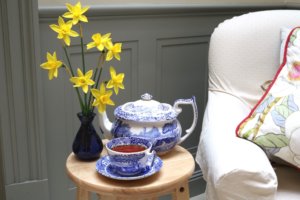
Simple but perfect – Narcissus ‘Jenny Out’ lasts well over a week in a vase
In my recent diligent daffodil studies I’ve not been lying in the grass and staring into their faces. It’s far too wet and cold for that. I’ve been picking them and bringing them into the house so I can really take in their appearance and delicate scent.
Despite the strength of their stems, I often find daffodils can give at the base in the wind or rain so cutting these ones off as they lie on the ground feels like a rescue mission.
My favourite daffodil in a vase is one I have in my garden called ‘Jenny Out’. The stems are very upright, the trumpet and sepals are petite and a matching mediterranean lemon yellow. It has a delicate scent and an outstandingly long vase life. It’s a cornish variety from Fentongollan farm.
Supermarket and florist daffodils are amazing value. They are usually £1 for 8 stems. These demonstrate the robustness and lust for life of the daffodil. They are cut, grouped and boxed with no water to be shipped round the country for sale.
Very few cut flowers can be treated so meanly and thrive – get them home, put them in water and within in hour or two of warmth the first the buds begin to pop open.
Many of these cut daffs come from Cornwall and Lincolnshire where you can see the bulb fields in bloom at this time of year. Many of the 100 varieties of bulb sold by Gee Tee bulbs are grown in Lincolnshire. Fentongollan Farm sell bulbs as well as cut flowers and will send mixed bunches through the post. It’s thrilling to see what you get when they pop open.
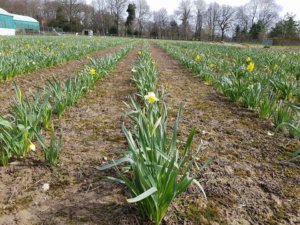
Daffodil fields for cut flowers at Peterley Manor Farm, Buckinghamshire
An increasing number of UK farmers are growing cut flowers for sale, including daffodils. A nursery near me, Peterley Manor Farm sells home-grown daffodils in their farm shop and whilst not on as big a scale as the cornish daffodil fields, it’s lovely to see the lines of yellow flowers beginning to open. Look out for local suppliers near you.
Daffodil planting and care
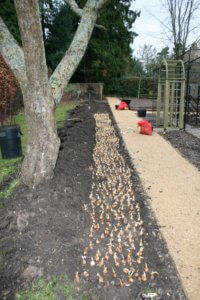
Planting a ribbon of daffodils alongside a path.
Plant your bulbs in autumn when a myriad of mail-order firms offer thousands of varieties.
Take your time over your selection. Have a cuppa and take a good look at the heights, forms and flowering times.
When deciding which daffodils to plant alongside a new path to my vegetable patch, I took ages to make my mind up.
I made sure that I chose two varieties that flowered in succession, meaning that I have a golden ribbon along my path for 5-6 weeks.
Each year they get better and better.
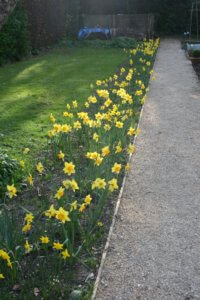
Cheerful guard of honour on the way to the compost heap
Daffodils are generally large bulbs and should be planted 5 inches deep. This means they’re easy to plant in borders but less easy in lawns or under trees.
The best method is to dig a trench, or series of large holes dotted around for a more natural look, then plant many at once. If you’re planting en masse, which is surprisingly cost effective, you will need to calculate how many bulbs you’ll need.
2.5kg of bulbs per metre square of grass will give you a sparse coverage, with 3.5kg per metre square a better option. 5kg of bulbs per metre square is probably the maximum possible to ensure they don’t outcompete each-other.
Resist the temptation to mow
After flowering, try to make time to snip the flower head off to avoid the plant putting energy into setting seed. Leaving the leaves to die down until about June is important as the dying leaves feed the bulb. It’s best to avoid tying or knotting them.
This is, I think, the most challenging part of growing daffodils in lawns. Many people hate the stragliness of the leaves. “Can’t we mow them yet?” asks my husband as the grass is over knee high and riddled with buttercups and other weeds.
I have the required patience, mainly because I wish to avoid my biggest bug-bear when it comes to daffodils – the blind clump. Or worse the blind row. Metres and metres of strappy green leaves with not a bud in sight. You often see these at roadsides. The impatient landowner, or clueless council sub-contractor, sentencing the daffs to an eternity of sterility by their eager mowing.
They don’t need much else but give your daffodils a bit of rest after flowering and they’ll reward you year after year.
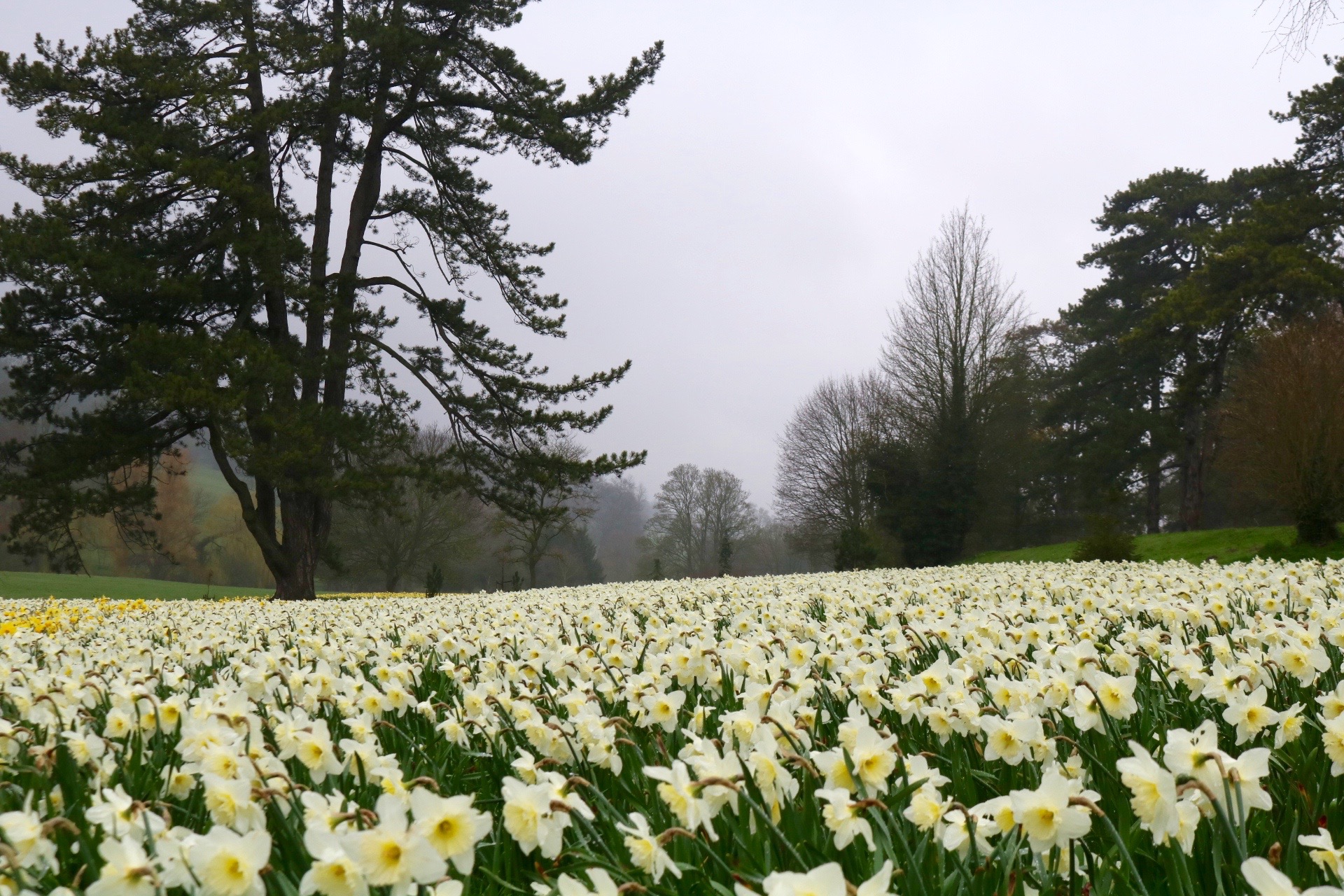
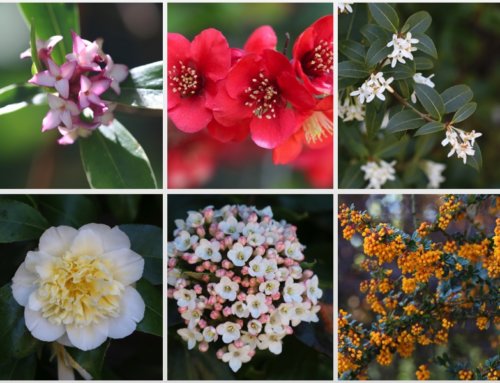
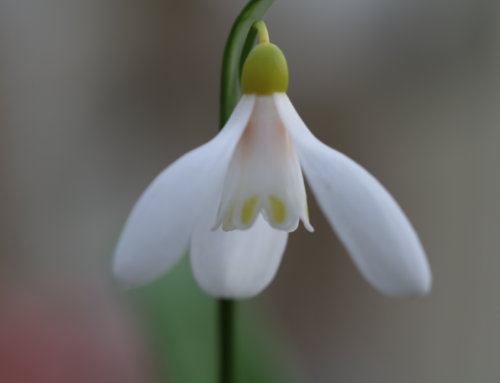
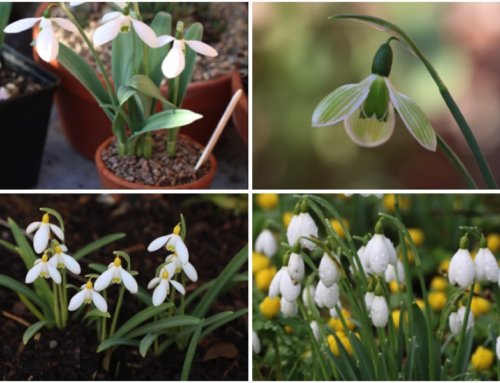
Brilliant Blog TBG. Got to admit I am thinking of planting more bulbs for next year.
Yes – you should plant more bulbs. Definitely. There are some really lovely ones out there and your succulents would look lovely next to them. Glad you liked the blog – I enjoyed reminiscing about my school daffodil debacle!